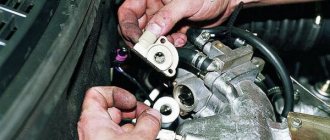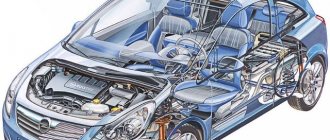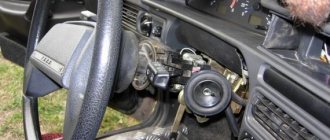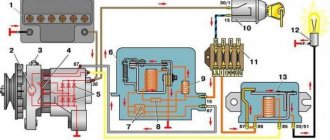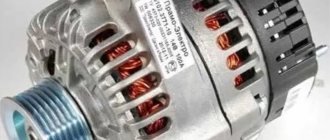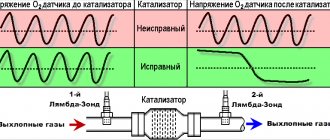Reasons prior generator does not work
Lada Priora (2013+). Basic generator malfunctions
When checking the generator, as well as when operating the car, you must follow a number of simple rules so as not to damage the generator:
– do not allow the generator to operate with the battery disconnected; – do not check the operation of the generator for a “spark”, since in this case a significant current flows through the diodes and they fail; – do not test diodes with voltages exceeding 12 V or with a megger; – when carrying out electric welding work, disconnect all wires from the generator and the battery; – check components and circuits of electrical equipment and eliminate malfunctions with the engine not running and the battery disconnected.
Cause of malfunction
Generator malfunctions - signs, diagnostics, causes, testing
Common generator problems:
pulley wear or damage; wear of current collecting brushes; wear of the commutator (slip rings); damage to the voltage regulator; short circuit of the stator winding turns; wear or destruction of the bearing; damage to the rectifier (diode bridge); damage to the charging circuit wires. Common battery faults: short circuit of battery electrodes/plates; mechanical or chemical damage to the battery plates; violation of the tightness of battery cans - cracks in the battery case as a result of impacts or improper installation; chemical oxidation of battery terminals. The main causes of these malfunctions are: gross violations of operating rules; expiration of the product's service life; various manufacturing defects. Of course, the design of a generator is more complex than a battery. It is quite reasonable that there are many times more generator malfunctions, and their diagnosis is much more difficult.
It is very useful for a motorist to know the main causes of generator malfunctions, how to eliminate them, as well as preventive measures to prevent breakdowns.
All generators are divided into alternating and direct current generators. Modern passenger vehicles are equipped with alternating current generators with a built-in diode bridge (rectifier). The latter is necessary to convert current into direct current, on which the vehicle's electrical consumers operate. The rectifier, as a rule, is located in the cover or housing of the generator and is integral with the latter.
generator structure. Generator in detail
All electrical appliances of the car are designed for a strictly defined operating voltage range. As a rule, operating voltages are in the range of 13.8–14.7 V. Due to the fact that the generator is “tied” with a belt to the engine crankshaft, it will work differently depending on the speed and speed of the vehicle. It is for smoothing and regulating the output current that the relay-voltage regulator is designed, playing the role of a stabilizer and preventing both surges and dips in the operating voltage. Modern generators are equipped with built-in integrated voltage regulators, colloquially referred to as “chocolate” or “tablet”.
It is already clear that any generator is a rather complex unit, extremely important for any car.
Types of generator faults
Due to the fact that any generator is an electromechanical device, there will be two types of faults - mechanical and electrical.
The first includes the destruction of fasteners, housing, malfunction of bearings, pressure springs, belt drive and other failures not related to the electrical part.
Electrical faults include winding breaks, diode bridge faults, brush burnout/wear, turn-to-turn short circuits, breakdowns, rotor beating, and relay-regulator faults.
Basic generator malfunctions
Often, symptoms that indicate characteristics of a faulty generator can also appear as a result of completely different problems. As an example, poor contact in the fuse socket of the generator field winding circuit will indicate a generator malfunction. The same suspicion may arise due to burnt contacts in the ignition switch housing. Also, the constant lighting of the generator malfunction indicator lamp can be caused by a breakdown of the relay; the blinking of this switching lamp may indicate a generator malfunction.
The main signs of a malfunctioning autogenerator:
When the engine is running, the battery discharge warning lamp flashes (or stays on continuously). Discharging or overcharging (boiling) of the battery. Dim car headlights, a rattling or quiet beep when the engine is running. Significant change in headlight brightness with increasing speed. This may be acceptable when increasing the speed (re-throttle) from idle, but the headlights, having lit up brightly, should not increase their brightness any further, remaining at the same intensity. Extraneous sounds (howling, squeaking) coming from the generator. It is necessary to regularly monitor the tension and general condition of the drive belt. In case of cracks and delaminations, immediate replacement is necessary.
Source: zinref.ru
Do-it-yourself VAZ 2110 generator repair
So let's look at the common malfunctions of the VAZ 2110 generator and how to repair them:
How to check the generator capacitor of a VAZ 2110
The capacitor of the VAZ 2110 generator is one of the elements of the car’s electrical circuit and is a capacitance consisting of a pair of electrodes isolated from each other by a dielectric.
Since the main task of a capacitor is the accumulation of electrical energy, its capacitance can be considered the main indicator (the larger the capacitance, the greater the accumulated charge). So, in the capacitor body, a positive charge accumulates on one of the plates, while a negative charge of equal magnitude accumulates on the other (connected to ground)
Replacing a capacitor in a VAZ 2110 generator begins with its diagnosis. The main parameter by which one can judge its damage is increased radio interference while the engine is running.
Advice! Make sure that the capacitor does not have loose contact with ground (which also contributes to noise).
Checking the bearings of the VAZ 2110 generator
Quite often the generator bearing fails, and the car owner will hear an obsessive hum when driving. But you don’t have to immediately go to a car service center; first, you can independently determine whether the problem is with the bearing.
How to understand a bearing failure?
- Visual inspection. If the design of the car allows, you can carry out an external inspection of the part for cracks in the area of the clips, metal damage, and wear of the seats.
- If there is a hum from the generator when driving, try tightening the fastening nut that secures the fan pulley. The cessation of extraneous noise after such manipulations means that replacement of the generator bearing is not required.
- Sometimes the hum stops after disassembling the generator and checking the starter with the rectifier unit. This also confirms that the generator bearing has nothing to do with it, but completely other parts are faulty.
- If the hum remains, the contact rings with brushes should be cleaned. This is best done with a regular rag soaked in gasoline. If the noise remains after this, then replacing the bearings is inevitable.
- As for the rear bearing of the generator, its failure is much easier to determine. To do this, shake the outer ring of the part and rotate it. If the ring rotates freely and there is no play or noise, then everything is in order. Otherwise, the spare part must be replaced.
- front bearing of the generator is checked in the same way as the previous one. You need to rock and rotate the front cover while supporting the pulley. Seizing, play, noise - all this indicates bearing wear.
Signs of an unusable generator bearing:
- Noise, hum, whistling sounds when the rotor rotates;
- Rapid and excessive heating;
- Rotating the pulley;
- Unstable charging.
No charger? Let's figure it out!
By the way, problems with charging on all those cars that I personally had to use occurred extremely rarely. For the most part, this began after the 90-100 thousand mileage mark. Priora is no exception. If on a relatively new car, when the new generator and all other components are in perfect order, these problems are practically eliminated, then on a used car, problems with battery charging can occur quite often.
Design features
So, before dealing with malfunctions, there is a principle of operation of the device. We take VAZ 2110, 21099 and 2109 as a basis. First of all, you should understand that this device actually works only due to electromagnetic induction. However, we will not delve into the basics of elementary physics, but rather let’s figure out what the device consists of that generates alternating current for the electronics of VAZ 2109, 21099 and 2110 cars. In the case of these cars, a classic type of generator is used, which has the following design:
- Rotary part of the device.
- Stator.
- Device body.
- Voltage regulator.
- Generator brush assembly.
- Rectifier block.
In general, if we talk about the generator as a whole - this device has exceptional reliability and breaks down very rarely, the main reason for the malfunction of the device that generates current for VAZ 2109, 210999 and 2110 cars can be the following factors:
- The parts for the generator are either counterfeit or defective.
- Exceeding operating standards (very rare due to the fact that those same standards are very high and difficult to achieve).
- Corrosion as a result of foreign liquids entering the mechanism, for example, salt water, road reagents or dirt.
In addition to these very basic faults, which are associated with mechanical or electrical breakdowns in the electrical system of the VAZ 21099, 2109, 2110. The case can be either typical or completely original. However, before undertaking repairs or diagnostics, it makes sense to study the qualifying signs of a generator malfunction.
Generator VAZ 2110
Why is there no battery charging and where to look for it?
In fact, there are a great many reasons why charging may fail. And most of them are connected with the most important unit in this regard - the generator. Let's look at the main ones that can most often occur.
- Wear of generator brushes on Priora. As mentioned above, when all the parts are still new and without wear, then such malfunctions essentially cannot exist. But when the mark is 90-100 thousand km. has already been overcome, the first calls begin. And the most common reason for the battery not charging is excessive wear of the brushes. This issue can be easily resolved - replace them with new ones. The price of the assembled part is about 350 rubles.
- The second reason can also be compared with brushes, since it is with this part that they come into contact during operation. These are the armature slip rings. It is worth removing the plastic cover of the generator and looking at the contact points of the brushes and rings to understand how much wear these parts have had! It is not always possible to carry out this replacement on your own, but almost any electrician will do it in half an hour.
- Failure of the generator diode bridge. Even if one of the diodes breaks through, there will be poor charging, which will lead to a constant discharge of the battery. In this case, the rectifier unit is replaced.
- Failure of the regulator relay - it is replaced as an assembly with the brush assembly, while the brushes themselves can be replaced separately (again, with the help of a good electrician).
- More serious problems occur with parts such as the stator, rotor, bearings, etc., which are actually much less common than the above cases.
Types of generator malfunctions
All malfunctions of this unit are divided into 2 categories - electrical and mechanical. Almost any mechanical failure is the result of prolonged use, leading to the destruction of the housing, fasteners, bearings, belt drive, pressure springs and other parts. Electrical faults include winding breakage, failure of the diode bridge, burnout of brushes and their wear, rotor runout, breakdowns, failure of the relay regulator.
It is necessary to regularly check the drive belt tension and wear.
Symptoms of loss of battery charging on a Priora
The very first thing that many people pay attention to is that the battery charging light on the dashboard came on. If you have a multimeter at hand, you can measure the output charging current by connecting the contacts to the “+” and “-” terminals, respectively. If even without a load the device readings are less than 13 Volts, this indicates that there are certain problems with charging.
Of course, it is possible (although it is highly not recommended) to remove the “-” terminal from the battery while the engine is running, thereby checking the functionality of the generator. If the engine stalls, this will indicate that there is actually no charging, and accordingly, the generator is faulty.
Also, the charging lamp may glow at half-glow, which also indicates insufficient charging current. If one of the symptoms listed above occurs, it is necessary to diagnose the generator and its parts. If necessary, replace them with new ones. If you have anything to add to this article, you can comment below.
Source: priora-remont.ru
Common malfunctions (signs) of the VAZ 2110 generator
So, it is very easy to determine that it is the generator that is acting up; just know a few basic signs of this - here they are:
- The device does not perform its main function, that is, it does not produce current. In this case, the car is driven only by the battery. Moreover, in this case you will not be able to travel far.
- The drive belt is spinning.
- The generator brushes are faulty.
- The rotor clings and touches the stator.
- There is no wire contact with the battery.
- The device begins to make a lot of noise.
- The battery does not charge while driving.
All these signs are very specific and only an experienced driver can identify them. However, if you have even slight doubts about the performance of the generator of VAZ 21099, 2109, 2110 cars.
Possible malfunctions of the generator on the Lada Priora VAZ 2170
| Cause of malfunction | Remedy |
| The warning light does not light up when the ignition is turned on, control devices do not work | |
| Fuse F12 in the mounting block has blown Open circuit in the power supply circuit of the instrument cluster: no voltage is supplied from the mounting block to the instrument cluster Open circuit in the power supply circuit of the instrument cluster: no voltage is supplied from the ignition switch to the mounting block The ignition switch does not work | Replace the fuse in the mounting block Check the connections of the orange wire from the mounting block to the instrument cluster and the wire itself Check the connections of the blue wire with a black stripe from the ignition switch to the mounting block and the wire itself Replace the ignition switch |
| The warning light does not light up when the ignition is turned on and does not light up when the engine is running, the control devices are working, the battery is discharged | |
| Instrument cluster malfunction Open circuit between the instrument cluster and the “D+” terminal of the generator Worn or stuck brushes, oxidation of slip rings Damaged voltage regulator The leads of the excitation winding have been unsoldered from the slip rings | Replace the instrument cluster Check the connections of the brown wire with a white stripe from the generator to the instrument cluster Replace the voltage regulator, wipe the rings with a cloth soaked in gasoline Replace voltage regulator Replace the generator rotor |
| The warning light is bright or lit when the engine is running, the battery is discharged | |
| Alternator drive belt slipping Damaged voltage regulator The rectifier block valves are damaged Damaged additional power diodes of the excitation winding Breakage of the excitation winding leads at the point of their attachment to the slip rings Open circuit or short circuit in the stator winding, shorting it to ground | Adjust the tension of the alternator belt Replace voltage regulator Replace the rectifier unit Replace the rectifier unit Replace the generator rotor Replace generator stator |
| The warning light is on when the engine is running and the battery is being recharged. | |
| Damaged voltage regulator | Replace voltage regulator |
| Increased generator noise | |
| Generator bearings are damaged Interturn short circuit or short circuit to ground of the stator winding (generator whine) Source: car-exotic.com | |
The charge lamp does not light up, some of the devices do not work?
The most common cause of this problem is a blown fuse.
. First of all, you should check it. To determine which fuse belongs to the generator, you can look at the diagram on the cover of the mounting block.
Power circuit problem
. Check the wires going to and from the mounting block. This is done by measuring resistance. Also check that the unit itself is working properly. Sometimes the problem occurs due to a failure of the contact group in the ignition switch. If necessary, replace the contact group and other damaged parts.
We recommend: DIY heated side mirrors
Removing and replacing the generator on a Priora: signs of malfunction, device, diagram
Having visited a car service center, the owner of a Lada Priora may be surprised how many components need to be disassembled to get to the generator. The experts will explain that VAZ 2170 models with air conditioning and power steering require a special approach. But in reality, the replacement is not as difficult as the service center workers describe it. It will take you a little over an hour to remove the timing belt and install a new unit. So that you understand what is discussed in the instructions, we have prepared additional materials: connection diagram and generator structure, unit labels. We also recommend studying the section that describes which generator to install on the Priora.
Troubleshooting
On modern cars, using the “old-fashioned” diagnostic method by removing it from the battery terminal can lead to serious damage to many of the car’s electronic systems. Significant voltage drops in the vehicle's on-board network can damage almost all on-board electronics. That is why modern generators are always checked only by measuring the voltage in the network or diagnosing the removed unit itself on a special stand. First, the voltage is measured at the battery terminals, the engine is started, and readings are taken while the engine is running. Before starting, the voltage should be about 12 V, after starting - from 13.8 to 14.8 V. A deviation upward indicates that there is an “overcharge”, which implies a malfunction of the relay regulator, and a deviation below indicates that no current is flowing. The absence of recharging current indicates a malfunction of the generator or circuits.
Circuit and device
The generator diagram shows how the unit is connected to other components of the car. Lada Priora with air conditioning and power steering received model 5102.3771, which has a number of advantages over generators of previous generations. Increased current output at low engine speeds is one of the advantages of the device: the timing rotor speed is reduced by 300 min, while the output is increased by 4-6 A. This innovation made it possible to use an automatic transmission, and also increased performance for the winter period.
The diagram shows that the operation of the device is monitored by a warning lamp that is installed in the dashboard. When you turn the key in the ignition, the lamp should light up, and after starting it should go out. This is how a working generator works. If the lamp continues to light while the engine is running, then there is a malfunction in the operation of the unit; the diagram will help you understand it.
Once the circuit has been studied, you can move on to the details of the generator.
We find and eliminate all malfunctions of the VAZ 2114 generator
Modern vehicles have many basic and additional equipment that require electric current to operate. The source of such current in the car is the battery, and to recharge it while the engine is running, a generator set is installed.
Generator
Symptoms of a problem
On automobile forums you can often see complaints from Lada owners with air conditioning about increased current. It is worth saying right away that the current cannot be increased - this applies to voltage. If the instruments show you that the current in the generator is too high, then you need to look for a problem in the relay. Electrical defects include burnout or wear of brushes, broken wiring and windings, damage to the regulator relay (increased current), and defects in the operation of the diode bridge. As for mechanical failures, these include worn springs and bearings, belt damage or damage to the housing.
You can understand that the Lada generator needs repair or replacement by the following signs:
- Extraneous sounds when driving that come from the right side of the hood.
- During diagnostics, the devices report that there is an increased current in the node. The scheme does not provide for this.
- The battery discharge indicator flashes or lights up even when the power plant is running.
- The headlights became dim.
- The brightness of the optics is constantly changing.
You can determine whether the generator with air conditioning is working or not by measuring its voltage. First you need to get the readings at the battery terminals, you need to start the engine and take the data while the Priora unit is running. Before starting, the voltage indicator should be 12 V, and after - from 13.8 to 14.7 V. If the deviation is in the smaller direction, then this indicates that there is no current flowing, and in the larger direction, there is an overload. The current cannot increase above the limit, so it is worth looking for the reason in the regulator relay.
Car generator maintenance
A car generator is a self-sufficient unit that does not require frequent careful maintenance. Its maintenance comes down to just a few operations, including:
- Periodically check the drive belt tension. In the operating instructions, this procedure is usually described separately for each specific car model. Low tension will cause the belt to slip with a characteristic squeak. An over-tightened belt will accelerate bearing wear.
- Blowing away dust and external contaminants. Blow out the generator with compressed air several times a year.
- Cleaning contacts. Monitor the condition and be sure to clean the contacts after oxides appear. Replace terminals and damaged wires as necessary.
- Replacing brushes. Many motorists do not wait for the generator to fail, but change the brushes every few years, depending on the recommendations of the car manufacturer and mileage.
The proper operation of a car generator mainly depends on the initial quality of the unit and the belt tension. Other factors influence to a lesser extent.
You can buy a generator for your car at a competitive price in our online store TopDetal.ru. We also sell components for generators of domestic and foreign production. From us you can order spare parts for generators with delivery by mail throughout Russia.
Expert help
Removal and replacement
The generator body should be marked so that it can be assembled later. Tags will be needed for motorists who want to disassemble its body. The marks will help in the final stage to correctly place the cover and secure all the fasteners.
If you want to carry out a full check or change the timing belt, then you won’t be able to do it without dismantling it. Below are instructions for Lada Priora with air conditioning and power steering. The difference from a car without air conditioning is that we will have to approach the generator from below. The car should be driven onto a viewing hole or a lift, after which the replacement begins. For repairs you will need a standard set of tools.
- Replacement begins with dismantling the engine protection;
- Now we move on to the timing belt tensioner pulley, we need to loosen its tension a little, check that the tension remains;
- Find the upper timing belt mounting bolt and unscrew it;
What is the best generator to install on a Priora?
If you had to change the standard 115A generator, then it is better to install a more powerful unit instead. Experienced motorists recommend setting the timing belt to no weaker than 170A, especially for lovers of good music in the car. We can advise you on what power you should stick with, but you must choose the model yourself. The only drawback of powerful units is the cost. If you don’t have extra finances to modernize your Lada Priora, then you should take a generator similar to yours - 115-130A. Now you know which timing belt is best installed on a VAZ 2170 with air conditioning.
Video instructions for replacing the generator on a Priora with air conditioning:
- Do-it-yourself replacement and tensioning of the alternator belt on a Priora with air conditioning
- Signs of malfunction, replacing the speed sensor on a Priora
- What kind of oil should I pour into the Priora 16 valve? Select by criteria
Uncle, do you even know what you’re writing about? these are your words “The instructions for the Lada Priora with air conditioning and power steering are described below.” ON PRIOR WITH AIR CONDITIONING, EUR IS INSTALLED AND NOT POWER STEERING. AND WHY DO YOU CALL YOUR UNCLE GENERATOR-TIMING? Timing belt - usually means belt. It's because of specialists like you that Russia is in trouble.
Source: remontvazov.com
